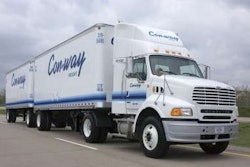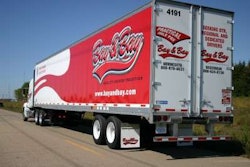ATA, FMC still fight aspects of ports’ arrangements
The Port of Los Angeles and Port of Long Beach on Feb. 18 began collecting the Clean Truck Fee at its marine container terminals. The ports established the CTF to help fund the implementation of the Clean Trucks Program, which aims to remove thousands of older diesel trucks from the fleet serving the ports. Cargo owners must pay a CTF for cargo moved by trucks that do not meet the requirements of the CTP. Cargo contained in a 20-foot container will be subject to a $35 CTF, while cargo moved in containers larger than 20 feet will be required to pay a $70 CTF. Trucks equipped with 2007 and newer diesel engines are exempt from the fees.
Last year, the West Coast Marine Terminal Operator Agreement created a not-for-profit company, PortCheck, to collect the fees for the ports. The money collected will be transferred to the ports to provide financial assistance for the replacement of thousands of trucks during the next several years. Under the CTP, the cargo owner is responsible for paying the fee, which must be paid before a container can enter or leave a terminal.
Beginning Oct. 1, 2008, the ports banned the most polluting trucks – 1988 and older rigs – in the first phase of the CTP. On Jan. 1, 2010, the ports will ban 1993 and older trucks, as well as unretrofitted model year 1994 to 2003 trucks. By January 2012, all 2006-model year and older trucks will be banned from entering port container terminals.
In addition, the Port of Los Angeles already had proceeded with efforts to encourage truck operators to purchase new current-emissions trucks. More than 100 companies have applied to receive $20,000 for each qualifying truck they had put into service at the port by Jan. 15. As a result of initial funding, the Port of Los Angeles says it now has about 3,000 clean trucks in service.
The Federal Maritime Commission currently is pursuing an injunction under section 6 of the Shipping Act against certain aspects of the CTP in the U.S. District Court for the District of Columbia. FMC has determined the CTP is likely, by a reduction in competition, to result in an unreasonable reduction in transportation services and an unreasonable increase in transportation cost. But last month, FMC determined that it was unnecessary to also try to block the PortCheck operation, clearing the way for the ports to begin collecting fees.
Meanwhile, the American Trucking Associations continues to challenge before the U.S. Court of Appeals for the Ninth Circuit the ports’ requirement that motor carriers sign concessionaire agreements. ATA argues that the concessions would impose a broad range of operational requirements that recreate a regulatory environment comparable to state intrastate economic regulation, which is federally preempted. The association says it is especially troubled by the Port of Los Angeles’ plan to ban independent contractors within five years.
Stimulus act offers retrofit funds, tax breaks
In addition to $27.5 billion in funding for highway construction, the new $787 billion economic stimulus act includes some measures that motor carriers may find useful. The act, signed into law by President Obama on Feb. 17, provides $300 million for diesel emissions reduction grants. The grants would be awarded under a program established by the Energy Policy Act of 2005 with the principal goal of reducing diesel emissions exposure from fleets operating in areas designated by the U.S. Environmental Protection Agency as poor air quality areas.
Under the program, almost all the funds must be allocated for projects using engine-related technologies certified or verified by either EPA or the California Air Resources Board. The 2005 legislation requires that at least 50 percent of the funds granted be made available for public fleets.
The stimulus package also extends for another year previously enacted measures that allow companies to deduct current expenditures on equipment up to $250,000 and to take advantage of bonus depreciation on capital purchases. Another provision that could help troubled small carriers that had until recently been profitable is an extension of net operating loss carrybacks for businesses that averaged less than $15 million in revenue over the past three years. For 2008 tax returns, businesses that qualify can carry back losses for five years, compared to two years under prior law, and may be able to amend prior-year returns for profitable years to claim tax refunds.
Employers that have reduced or may need to reduce employment levels need to pay close attention to a measure subsidizing COBRA benefits for involuntarily terminated employees. Employees terminated between Sept. 1, 2008, and Dec. 31, 2009, will be required to pay only 35 percent of the premium, with the employer covering the remainder. The employer, in turn, will receive reimbursement through a payroll tax credit and, ultimately, a payment from the U.S. Treasury if the tax credit does not cover the employer’s entire premium cost. Terminated employees who previously had not elected COBRA coverage have 60 days from the Feb. 17 effective date to enroll.
Analyst: Outlook still gloomy for 2009
Chicago Fed economist sees some positives Growth in the Gross Domestic Product likely will be “quite weak” for most of 2009, and even after an expected turn in the second half, growth will be below long-term trends. That is the assessment of William Strauss, senior economist and economic adviser for the Federal Reserve Bank of Chicago, who addressed the Heavy Duty Manufacturers Association’s Heavy Duty Dialogue last month.
Strauss warned attendees at the outset that his news would not be good, saying that “the charts I’m going to put up are kind of scary.” The current recession will be long – potentially 18 to 24 months compared to the average of 11 months, he said. The decline in GDP from beginning to end of the recession likely will be about 1.8 percent, slightly higher than the average 1.4 percent drop. But one of the biggest worries is the job loss, which could reach 3 to 4 percent rather than the 1.6 percent average.
Industrial production likely will continue to fall in 2009, although at a slower rate than in 2008, Strauss said. Industrial production dropped sharply in the second half of 2008 and was down 6 percent for the year. In 2009, industrial production is forecast to fall 2.7 percent before rising 3 percent in 2010.
Another key measure of economic activity – housing – looks to face another bad year, Strauss predicted. “The supply of new single-family homes is extremely high.” Although some areas are doing far worse than others, on a national basis there’s about 13 months of housing inventory without any construction.
Net exports due in part to a weak dollar had been offsetting domestic weakness, but that too fell off in the second half of 2008 due to a global slowdown. “What we’re experiencing in the United States is happening around the world,” Strauss said.
There are some positives, however, Strauss told Dialogue attendees. Inflation has reversed course – in large part due to the movement of oil. “Every 1-cent drop in the price of gasoline adds a billion dollars to consumer spending.” Core inflation now is in the “comfort zone” and likely will moderate in the years to come. Unfortunately, the reasons for softness in prices for goods and services include the 3.6 million jobs lost since December 2007 and the pullback in consumer spending since the first half of 2008.
Another positive trend is that productivity remains solid, Strauss said. And if there are silver linings to the collapse in the residential housing market, it’s that the market can’t go much lower and the impact of housing on the overall economy is diminished. “There’s only so long you can fall at a 20 percent rate, and a 20 percent decline in housing today is not equal to a 20 percent drop a couple of years ago.”
Finally, Strauss reassured the audience that while the recession is long and deep, it’s nothing like the Great Depression when GDP plummeted 26 percent and unemployment reached 25 percent. Then, the government had no backstop for banks like today’s Federal Deposit Insurance Corporation. The Federal Reserve did not respond aggressively the way it is doing now. And because balanced budgets were assumed, the federal government reduced its own spending as tax receipts fell due to a slower economy.
– Avery Vise
ATA proposes ditching UCRA
The American Trucking Associations is proposing the elimination of the relatively new Unified Carrier Registration Agreement (UCRA) program and replacing it with direct federal payments to states through the Motor Carrier Safety Assistance Program. The approximately $100 million necessary to replace UCRA would come from an increase in the federal fuel tax of a fraction of a cent.
The UCRA board of directors last month recommended that the Federal Motor Carrier Safety Administration approve by rulemaking a 120 percent jump in the fee per vehicle. A change in the fee structure was necessary in any case given the congressional action last year to eliminate trailers, but ATA argued that the current fee level should remain in place given the financial strain motor carriers are facing.
ATA President Bill Graves lodged the trucking industry’s protest Feb. 20 in a letter to 50 state governors. According to ATA, one of the problems with the program is lower-than-anticipated revenues due to lack of enforcement by states. So in effect, the UCRA board is proposing to punish carriers that comply with the regulations by raising their fees to offset losses from noncompliant carriers, ATA says.
In Brief
Freight Transportation Services Index fell 2.3 percent in December from its November level, the U.S. Department of Transportation’s Bureau of Transportation Statistics reported. The December decline – the fourth monthly decrease in five months – dropped the freight index to a loss of 3.0 percent for 2008. The index was up 2.7 percent for the first seven months of the year but declined 5.5 percent in the final five months.
YRC Worldwide Inc. announced
Feb. 12 that it has finalized an amendment with the company’s lenders of its credit facilities and renewed its asset-backed securitization facility two months prior to maturity. “We feel good about the amendment that we reached and the flexibility it will provide us to help weather this economic recession,” said Tim Wicks, executive vice president and chief financial officer.
Old Dominion Freight Line Inc. increased its base rates effective Feb. 16 with increases based on the length of haul rather than the traditional across-the-board less-than-truckload increases. The overall increase from the varying rate hikes was 5.6 percent.
UPS has deployed 300 new delivery trucks powered by compressed natural gas (CNG) to seven cities in Colorado, Georgia, Oklahoma and California. UPS says it already operates the largest private fleet of alternative fuel vehicles in its industry — 1,819 in total with these additions.
J.D. Power and Associates Founder’s Award was presented to Paccar for its longstanding commitment to customer satisfaction in the commercial vehicle industry. Tom Plimpton, vice chairman of Paccar, received the award from J.D. Power and Associates last month at a Heavy Duty Manufacturers Association meeting in Orlando, Fla.













